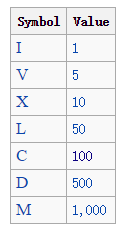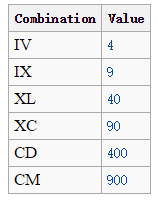Roman numerals are represented by seven different symbols: I, V, X, L, C, D and M.
Symbol Value I 1 V 5 X 10 L 50 C 100 D 500 M 1000
For example, two is written as II in Roman numeral, just two one’s added together. Twelve is written as, XII, which is simply X + II. The number twenty seven is written as XXVII, which is XX + V + II.
Roman numerals are usually written largest to smallest from left to right. However, the numeral for four is not IIII. Instead, the number four is written as IV. Because the one is before the five we subtract it making four. The same principle applies to the number nine, which is written as IX. There are six instances where subtraction is used:
Ican be placed beforeV(5) andX(10) to make 4 and 9.Xcan be placed beforeL(50) andC(100) to make 40 and 90.Ccan be placed beforeD(500) andM(1000) to make 400 and 900.
Given a roman numeral, convert it to an integer. Input is guaranteed to be within the range from 1 to 3999.
Example 1:
Input: "III" Output: 3
Example 2:
Input: "IV" Output: 4
Example 3:
Input: "IX" Output: 9
Example 4:
Input: "LVIII" Output: 58 Explanation: L = 50, V= 5, III = 3.
Example 5:
Input: "MCMXCIV" Output: 1994 Explanation: M = 1000, CM = 900, XC = 90 and IV = 4.
这一题是LeetCode Integer to Roman的姊妹篇,只需从左往右依次解析字符串即可,优雅版本如下:
class Solution {
public:
int romanToInt(string s)
{
vector<int> nums = { 1, 4, 5, 9, 10, 40, 50, 90, 100, 400, 500, 900, 1000 };
vector<string> symbol = { "I", "IV", "V", "IX", "X", "XL", "L", "XC", "C", "CD", "D", "CM", "M" };
int ans = 0;
for (int i = nums.size() – 1; i >= 0; i–) {
int sz = symbol[i].size();
while (s.size() >= sz && s.substr(0, sz) == symbol[i]) {
ans += nums[i];
s = s.substr(sz);
}
}
return ans;
}
};本代码提交AC,用时68MS。

